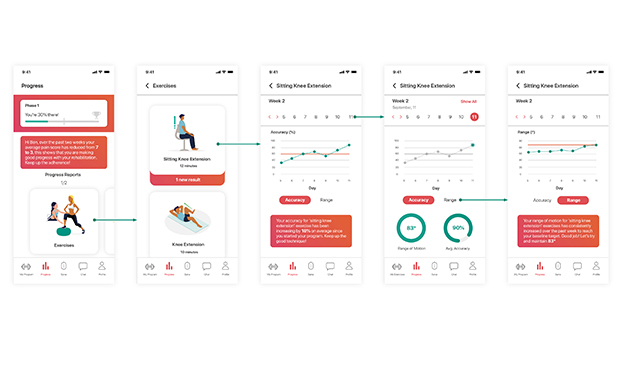Knee surgery patients could get match fit faster and avoid painful osteoarthritis by doing their rehab reps at home wearing an intelligent e-textile bandage linked to their phone.
Knees take some of the hardest knocks in sport and 50% of knee injuries tear the hard-working anterior cruciate ligament (ACL) which is then rebuilt or replaced with surgery.
A third of people who have the operation risk osteoarthritis in that knee within 10 years because they don’t properly stick to their rehab exercises or they under or overload their knee after.
Sana is a sleeve bandage studded with motion sensors that pairs with a smartphone app and lets patients and their physiotherapists track their recovery from home. Its Brunel University London developers say in a study published in Applied Sciences the user-friendly wearable can dramatically improve post-ACL surgery rehab for patients and physios.
“It’s the first digital remote knee rehab system of its kind that addresses the specific needs of anterior cruciate ligament reconstruction recovery, through gamification and behavioural design,” said creator, Tanaka Kungwengwe.
“There’s many digital rehab apps on the market for knee surgery,” said the first-class design graduate. “But these are mostly targeted at recovery from total knee replacement surgeries and not ACL injuries.”
The ACL is a band of dense connective tissue between the thigh bone and shin bone. It most often tears in sports like football and basketball, where players, jump, land and switch direction suddenly. With about 15,000 reconstructive ACL surgeries a year in the UK costing £63 million, patients not sticking to their rehab exercise plans puts a major burden on healthcare services. It takes people up to two years to recover and physiotherapists blame high rehab drop-out rates on the boring, unresponsive paper print-out exercise regimes patients are left alone to follow.
The Sana system is made to measure for each patient. Physiotherapists look at movement in the patient’s ‘good knee’ to set exercises and ranges of movement to bring their recovering knee back up to speed. Physios set goals that are realistic for that particular patient and give feedback remotely. The phone app tells users how well they’re doing with the exercises and if they are doing them right while the basic game element distracts people from pain and boredom.
Users in early tests said the system is easy to use, motivating and unobtrusive while physios said it can potentially improve how they organise treatment, make decisions and personalise their patients’ care. Tanaka is now looking for funding and investment to fine-tune the app’s design and software plus patent the wearable that will accompany the mobile application.
“Our current design focuses on phase one rehabilitation,” said Tanaka, 22, from Wolverhampton. “However, all phases need to be completed to ensure that a patient recovers optimally, so further design development will explore how to incorporate phase two and three into the system. I strongly believe that my concept will have a positive contribution to ACL rehabilitation and clinical practice.”

Image: CHUTTERSNAP on Unsplash